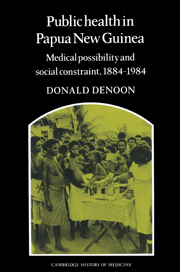Book contents
- Frontmatter
- Contents
- Acknowledgements
- Maps of Papua New Guinea
- Introduction
- I The rise and fall of tropical medicine
- 1 Pre-colonial health and disease
- 2 The administration of public health
- 3 Early colonial medical administration
- 4 The political economy of health in Papua between the wars
- 5 The political economy of health in New Guinea between the wars
- 6 Medical education
- 7 The Pacific War: the condition of the people
- II The rise and fall of the great campaigns
- Notes
- Bibliography
- Index
6 - Medical education
Published online by Cambridge University Press: 11 February 2010
- Frontmatter
- Contents
- Acknowledgements
- Maps of Papua New Guinea
- Introduction
- I The rise and fall of tropical medicine
- 1 Pre-colonial health and disease
- 2 The administration of public health
- 3 Early colonial medical administration
- 4 The political economy of health in Papua between the wars
- 5 The political economy of health in New Guinea between the wars
- 6 Medical education
- 7 The Pacific War: the condition of the people
- II The rise and fall of the great campaigns
- Notes
- Bibliography
- Index
Summary
The early medical authorities in colonial Papua – whose own life expectancy was a matter of nervous doubt – had no opportunity to teach each other nor to instruct Papuans. Breinl's visit from the Institute of Tropical Medicine encouraged Strong's interest in the bowel parasites of plantation workers, but the official record makes no reference to formal teaching. Informally, though, doctors encouraged settlers to take their bitter quinine regularly, and through the Handbook on the treatment and prevention of disease in Papua when medical advice is unobtainable (that is, for most of the people, most of the time) to dress wounds, purge fevers, and remain cheerful. The hookworm campaign involved a programme of lectures on personal hygiene in Lambert's idiosyncratic pidgin, and government patrols encouraged the building (and use) of pit latrines, and discouraged traditions of allowing corpses to decompose in villages.
Their German counterparts were better equipped to embark on an educational programme, and in the few years before the Great War a number of heil tultuls received a few weeks' instruction in hospitals, before they returned to their villages. The vaccination programmes had an educational dimension as well; although some missionaries intruded more theology than therapy into their advice. The innovation of heil tultuls was one of very few German ideas to survive the transition to Australian rule:
This training [as ‘medical tultuls’] consists of teaching how to dress and treat tropical sores and other diseases, the recognition of cases requiring hospital treatment, administering treatment ordered by medical officers under the supervision of European medical assistants, assisting at operations, elementary rules of sanitation and the methods of quarantining infectious or contagious cases etc. […]
- Type
- Chapter
- Information
- Public Health in Papua New GuineaMedical Possibility and Social Constraint, 1884–1984, pp. 53 - 57Publisher: Cambridge University PressPrint publication year: 1989

